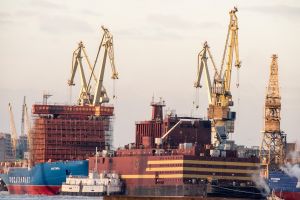Russia: Floating nuclear power plant to cast off from Saint Petersburg
In Saint Petersburg at the Baltic Shipyard in the center of Russia's second biggest city the floating nuclear power plant (NPP) "Academician Lomonosov" has been constructed. It is a new experimental vessel with two reactors supposed to be in operation at its final destination in Pevek in Chukotka in the Russian Far East. There hasn't been a transboundary Environmental Impact Assessment, and it is not planned for future either. Russian authorities emphasize that the country never ratified the ESPOO convention, and thus would not be required to involve the neighboring countries - which will be affected by the shipment of the floating NPP to its final destination in autumn 2017 or spring 2018. On this route is has to cross the Baltic Sea passing the waters of the territories of several other countries. However, the country signed the ESPOO convention, and Russian documents recommend to meet the requirements of this treaty if applicable.
The very concept of a floating nuclear power plant is unacceptably dangerous. In the event of an accident with a release of radioactivity vast areas can get contaminated. In case of floating nuclear power plants, piracy and terrorism add to the usual list of risks of natural hazards as earthquakes and tsunamis. If a floating NPP gets hijacked the perpetrator would get hold of a significant amount of by almost 20% enriched uranium, and a chance for nuclear blackmail.
The history of Russian ships with nuclear reactors has already proved the risks of accidents: In 1970 at the Krasnoe Sormovo factory in Nizhny Novgorod the reactor of a submarine under construction started spontaneously causing twelve casualties, hundreds had been irradiated above limits, the factory building was contaminated. In 1985 in the Chazhma accident an explosion occurred in Russia's Far East during re-loading of fuel leading to ten casualties, hundreds of people had been irradiated and an area of about 5.5 kilometers were contaminated.
In Chukotka the Beloyarsk NPP is going to be decommissioned, which officially is declared the cause for replacement by the floating NPP there. But: The four Beloyarsk reactors only have a capacity of 12 MW each. All in all it makes 48 MW of capacity which should be easily substituted by other means. Besides, the capacity factor of Beloyarsk NPP is the lowest among Russian NPPs: about 50%. Ten years ago it was even lower, about 35%, and it was officially stated that the reason is low demand. Thus, a replacement by another nuclear installation is not needed in Chukotka.
Greenpeace is stressing that the floating NPP project is built by Rosatom not for powering the remote regions of Russia itself, but to have a working floating reactor for possible international customers, taking into account it's cheaper than an "ordinary" NPP, so the entry barrier is lower and more countries could afford it, and to show that the corporation has the capacities to complete a reactor, even a small one, while NPP reactors e.g. by France are still delayed and times over budget.
More information:
- Greenpeace protests against the launch of fueling of a nuclear power plant inside the city of St. Petersburg English
- Гринпис России требует от губернатора Петербурга остановить опасный ядерный эксперимент Russian
- Greenpeace petition against the floating NPP: Петербург возмущен безответственностью атомщиков Russian


